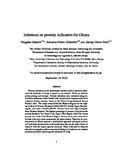| dc.contributor.author | Jakperik, Dioggban | |
| dc.contributor.author | Otieno, Romanus Odhiambo | |
| dc.contributor.author | Orwa, George Otieno | |
| dc.date.accessioned | 2018-10-30T08:54:03Z | |
| dc.date.accessioned | 2020-02-06T13:03:41Z | |
| dc.date.available | 2018-10-30T08:54:03Z | |
| dc.date.available | 2020-02-06T13:03:41Z | |
| dc.date.issued | 2018-09-14 | |
| dc.identifier.uri | http://repository.must.ac.ke/handle/123456789/914 | |
| dc.description.abstract | Poverty indicators are the fundamental statistics used to optimally determine the standards of living of people in any country. These are used for policy planing and analysis. Poverty indicators were estimated using linearization techniques with a fourth-order multiplicative semiparametric bias reduction density estimator based on the Ghana Living Standards Survey
Round 6 data. The study revealed that the Western Region has the highest At-Risk-of-Poverty Threshold (GHC3,935.67) with the Upper East having the least value of GHC1,003.79. Poverty levels were high among the three Northern Regions. The highest percentage of persons living below the poverty threshold was found in the Upper West Region whilst the lowest
percent was found in the Western Region. Poverty levels were observed to be high in the rural areas compared to the urban centers. Therefore, to combat poverty in Ghana requires a multifaceted approach with good political will and much concentration on the youth since they are the major source of labour to feed the largely agrarian economy. There is the need to intensify education among the youth on capacity building in all endeavors to enhance productivity, hence improving their standards of living. | en_US |
| dc.language.iso | en | en_US |
| dc.subject | Poverty indicators, linearization technique, Living standards, density estimator, Quantile | en_US |
| dc.title | Inference on poverty indicators for Ghana | en_US |
| dc.type | Article | en_US |

